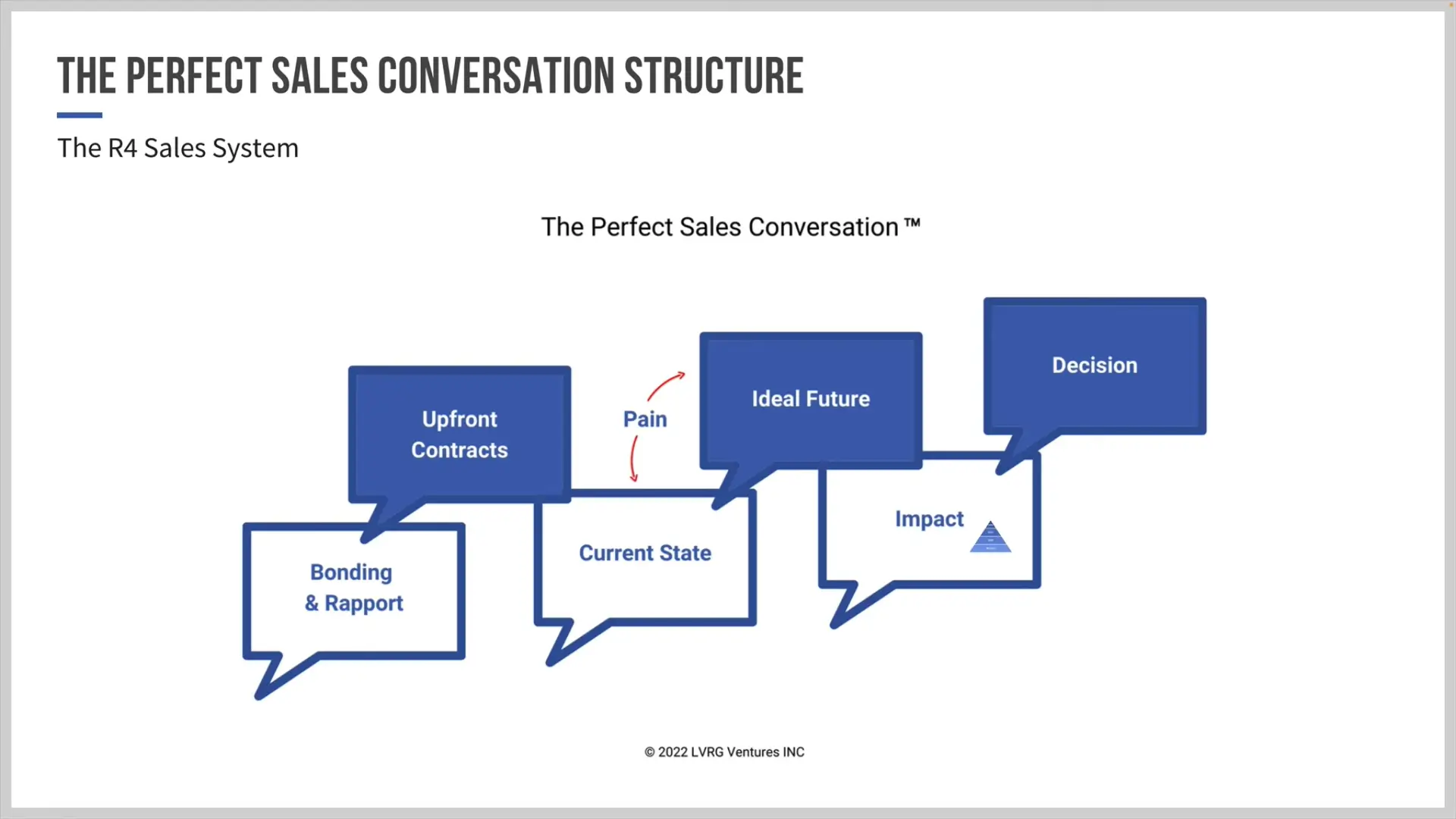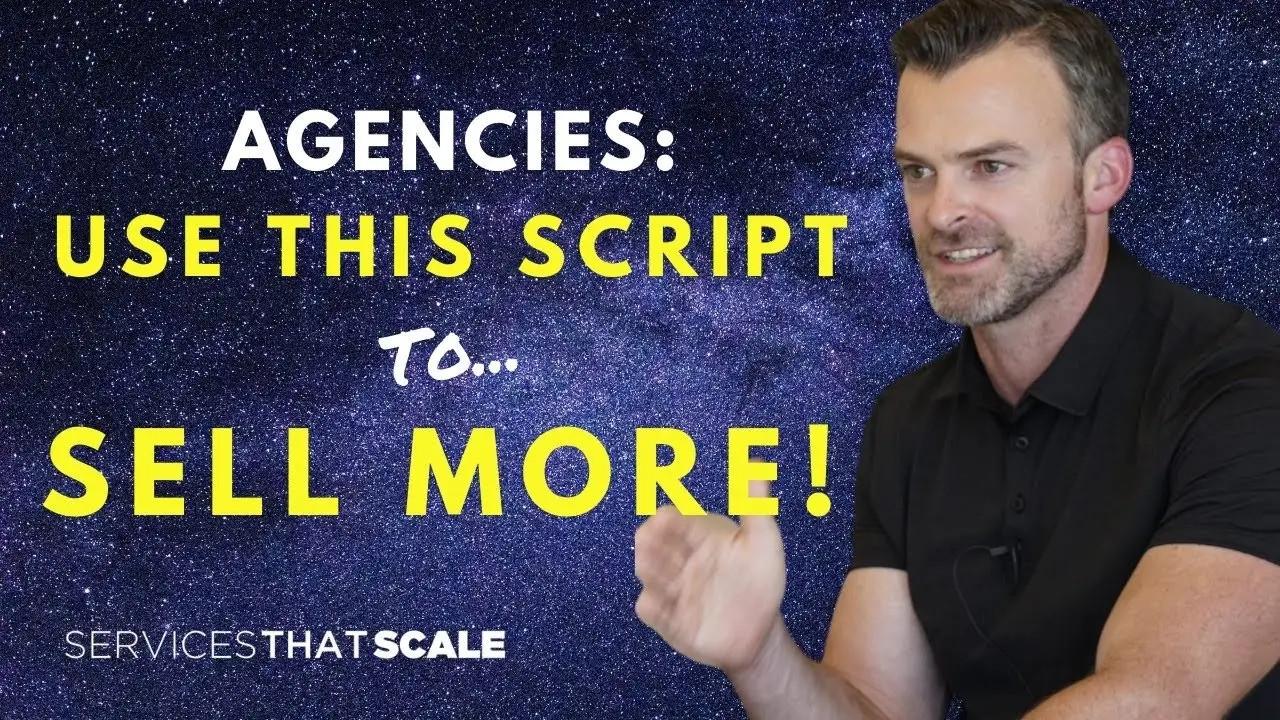Closing deals is the lifeblood of a profitable agency. Yet it’s easy to slip into being seen as a stereotypical sales rep—aka someone to be tolerated until they go away. In this post, we’ll break down a proven sales script for dramatically increasing your close rate. While cementing your position as a trusted strategic advisor.
You’ll learn:
- How to handle objections before they arise
- A formula for guiding strategic sales conversations
- A simple close to confidently sign clients
The goal is control and consistency, turning more prospects into long-term clients. While being seen as a partner, not a vendor hustling commissions.

Risks of Relying on Charm & Chance in Agency Sales
Here’s the reality—most small business buyers lack structured procurement processes. And defined budgets for the services you sell.
Sure, they have money to spend. But allocating it towards marking, web development, design, and so on likely falls low on the priority list. At least until they experience enough pain from DIY efforts going nowhere.
This means convincing them to invest requires skill. It demands some artful positioning. To awaken the realization that they want—no, need!—exactly what you offer.
But attempting to do this on the fly brings risk. Relying purely on charm and chance is unlikely to efficiently scale an agency. At least not without loads of wasted time chasing dead-end conversations.
While gritting your teeth through discounted rates to close the occasional deal.
Missing is a consistent blueprint guiding prospects from:
The initial spark of interest → Intrigue around your difference as the solution → Desire for change → Decision to engage

The Key is Consultative Sales Conversations
True authority comes from living in the nuanced realities of an industry. Combined with having already mapped pathways through its obstacles towards the desired destination.
You demonstrate this through consultative sales aimed at adding value on the prospect’s road. Not wanting to convince them your route is best by any means necessary.
When restraint is shown in taking their side over self-interest, you earn positioning as an advisor first. This opens the door to influence based on hard-won insight—not manipulation.
Consultative sales utilized by respected industries like management consulting firms make recommending the optimal solutions far easier during closing. Since they arise logically from an insightful dialogue versus feeling “sold” something.
Now I’m going to give you an exact framework to structure this dialogue.
Grab My Free Training
Learn the Four Best HighLevel Services to Start a Digital Agency FAST!
A Proven Sales Script Optimizing Sales Conversations
Here is an overview of the consultative sales process you can use to guide strategic conversations:
- Bonding & Rapport
- Upfront Contracts
- Current State Analysis
- Future State Vision
- Impact Demonstration
- Simple Close

While this resembles other proven sales methods, customizations around upfront contracts and closing set this methodology apart when selling sophisticated services.
1. Bonding Sets the Table
You’ve heard it a thousand times—people buy from those they know, like, and trust. Yet the mistake made too often is charging right into sales mode before rapport building.
Without first setting the table by bonding personally, attempts at sophisticated positioning fall flat. Since the other party focuses mainly on wondering who this person really is in front of them.
While requirements differ between prospects, generally, 5–15 minutes should be invested in discussing non-business topics of common interest before transitioning.
All you need to do is demonstrate genuine curiosity about one or two relevant personal or professional interests mentioned by the client earlier during small talk.
Key is shifting gears when moving into the sales discussion so they understand you now wish to address their needs.
2. Upfront Contracts Guide Expectations
Here is where we deviate sharply from most sales playbooks. Rather than assuming all kinds of silent contracts during our opening pitch…we’ll lay terms out transparently through what’s called an upfront contract.
This means explicitly:
- Setting rules of engagement
- Confirming they can comfortably decline
- Establishing your prices are known quantities
The last two may seem counterintuitive if trained to withhold pricing strategically. But for consultative sales, it sets the honest tone desired for positioning.
First, you ask the client to give you a “no thank you” at any point should they decide your solution is not a good fit. Granting clients comfort to bow out without awkwardness demonstrates sales discussions aren’t coercive here.
And can save you from wasting your time on discussions where the client already knows they aren’t going to go for your offer but continues anyway.
Next, pricing frameworks are presented before proposing services. Once prospects hear what you charge for results, they can determine if investing seems reasonable. Again transparency builds trust in positioning.
If, after both disclosures, they remain engaged? You know money matters are addressed, plus they have a genuine interest in exploring your process.
When buyers don’t feel cornered into hearing a pitch, smart folks decide if working with you makes sense.
3. Current State Sets the Context
Here’s where we express a genuine desire to understand their goals and frustrations, where additional support is needed, etc.
This serves several purposes:
- Builds familiarity with their reality
- Surfaces urgent pains
- Reinforces their goals requires outside assistance
- Highlights gaps between their current and desired state
That gap becomes crucial later.
For now, focus intently on asking incisive questions and then LISTENING. Resist the urge to jump to proposing anything yet. No matter how obvious the solution may seem.

Beyond building rapport, you’re gathering intel to customize your demonstration of impact coming up next.
4. Future State Sets the Frame
Having established where they stand, now environments are imagined IF they achieve their goals and their sought-after success comes to fruition.
This requires envisioning concrete details around:
- Key metrics improved
- New opportunities/options available
- Revenue or profit markers achieved
- Personal scorecards made possible
- Other outcomes unique to their scenario
Again resist prescribing anything specific to make numbers. Stick with asking “what if” to draw their desired scenario out.
Their answers frame the conversation for aligning available resources with tangible targets.
Now we get to position our systematic solutions as the missing bridge between current and potential realities.
5. Impact Demonstrates the Difference
At last, the moment arrives to showcase your systems delivering the desired outcomes. This is where you craft a signature solution optimized for the client’s scenario and aligned directly to their precise hurdles and targets.
The key is to detail exactly how step-by-step processes you bring lead from where they stand all the way through to hit their quantified targets.

This clarifies your systematic approach as the difference between staying stuck and achieving goals—the bridge between current and desired state.
6. Closing Confirms the Partnership
Finally, the moment of commitment arrives. Yet rather than launching into fancy tricks, we take temperature.
Take stock of remaining questions, address concerns, and then confirm mutual alignment towards progressing ahead.
It goes like this:
You: Well, Mr. Prospect, based on our conversation so far, are there any remaining questions about the potential value or process for us working together from here?
Them: (Clarifying Questions)You: Wonderful. Well, given you’ve communicated [X Goals] are key outcomes you’re committed to achieving, I’m confident our [Y Years Of Expertise Delivering Z Result] present a great fit here for synergizing efforts from this point forward. Does beginning the process with [Next Action Step] over the next week or so seem like a reasonable next move?
And then silence. THAT’S IT!
If there are no remaining disconnects? Congratulations, a new client is yours!
If there are last sales concerns, directly address them using established trust and intel gathered earlier to reaffirm the fit. But only if necessary.
Otherwise, everything needed for them to confidently engage should be paved already through your consultative approach.
Now seal the continuation of your partnership by instantly scheduling follow-up meetings, paperwork signing, etc., around said next action step.
Now let’s examine the final piece towards complete confidence in engaging any prospect—an air-tight methodology for you to reference throughout discussions.
Deploy The R4 Strategic Growth Framework
I often get asked for a handy model simplifying the marketing methodologies I continually reference when working with clients. So I devised a system pulling everything together.
This serves as an omnipresent guide throughout sales engagements, visually encapsulating core solutions. Strategically referenced at each phase from opening till close.
Here’s how it works…
The R4 Framework symbolizes the four key drivers fueling rapid business expansion when strategically addressed:
- R1: Reputation—Building credibility and trust in your marketplace
- R2: Resale—Earning repetitive sales from recurring clientele
- R3: Reach—Extending audience awareness steadily through promotion
- R4: Retargeting—Remarketing progressively to prior prospects
The four marketing pillars represent the necessary stages toward complete market domination. Like building a house, you can’t put the roof up before the foundation gets laid.
This model simplifies an otherwise complex interplay of coordinated marketing, sales, and customer success tactics with an easy-to-repeat motif.
Use it to help you explain how your specific solutions cater to the prospect’s expansion goals and growth visions. (Drawing it on a whiteboard or napkin can be very effective since it demonstrates your mastery of the concept.)
The R4 framework is there to serve as an anchor throughout your client conversations to repeatedly convey your expertise. It symbolically demonstrates how your suite of services strategically aligns with their stepped growth journey in a proven way.

It bounds the full spectrum vision of channels, messaging sequencing, conversion optimization funnels, nurture tracks, automation, integrations, and other moving parts into one stabilized model, always leading clients forward.
Your agency promises expert guidance—the R4 delivers confidence at a glance. It symbolizes that you’ve already worked everything out for guaranteed progress with them into the future.
Confidently Master Consultative Agency Sales
The consultative sales script framework detailed here stands the test of time. I’ve been using it successfully for about a dozen years and have trained hundreds of agencies to use it, too.
These best practices continue yielding tremendous results after optimizing countless client acquisitions over the years. I know they will do the same for you if you start implementing them in your agency today!
All the best,
PS – I made six shifts in my approach to building my business that allowed me to grow quickly and stop trading my time for money. You can learn them here 👈🏻
PPS – Here are two ways to get involved with our community of entrepreneurs. Both will give you everything you need to go from where you are today to running a successful seven-figure agency:
Click here to sign up for HighLevel CRM through me. All of my HighLevel CRM customers get access to Moguls for FREE—Just part of the huge Bonus Package I provide.
Click here to join Moguls directly. You’ll get access to all of our live boot camps, content, and community that have helped folks just like you scale to seven figures and beyond!



